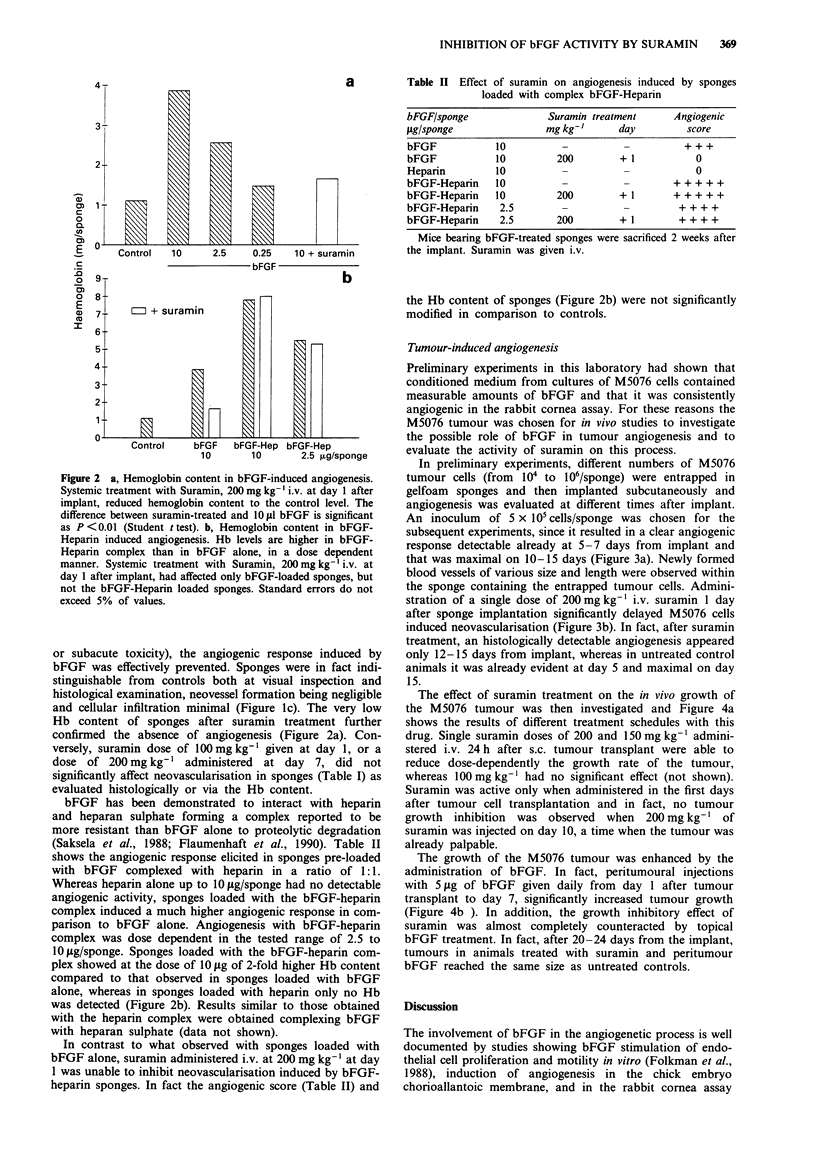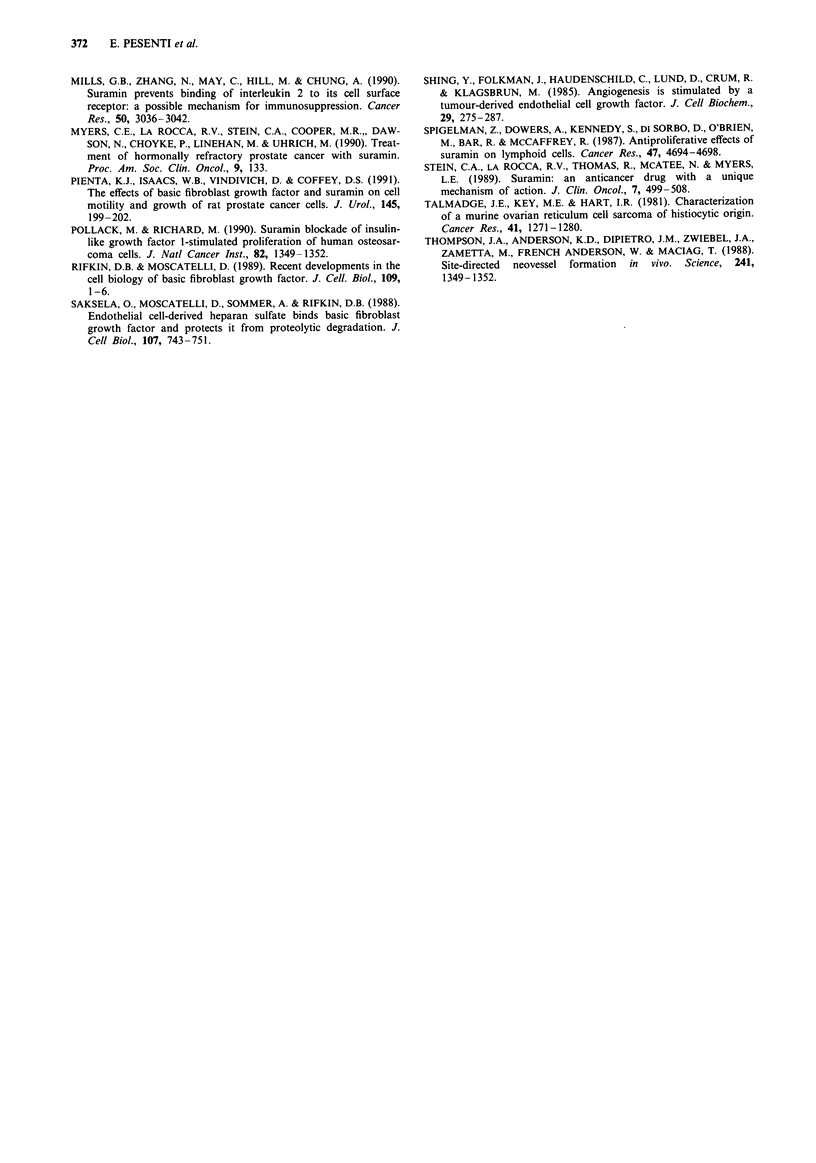Abstract
Inhibition of angiogenesis through blocking of growth factors involved in this process could be a novel therapeutic approach in several important pathologies, neoplasia among them. Suramin has recently been described to possess antineoplastic activity in animals and humans, and it has been proposed that an important role in this activity is played by antagonism of growth factors and especially bFGF. To investigate this hypothesis in vivo, we used gelatin sponges loaded with bFGF and implanted subcutaneously in mice. Suramin showed an inhibitory activity on bFGF-induced angiogenesis, whereas it was inactive in the case of heparin-complexed bFGF. Suramin was also studied in an in vivo model of tumour-induced angiogenesis using the murine M5076 reticulosarcoma, a tumour producing significant levels of bFGF. Suramin was able to reduce tumour growth and tumour induced angiogenesis, and exogenous administration of bFGF countered suramin effects.
Full text
PDF





Images in this article
Selected References
These references are in PubMed. This may not be the complete list of references from this article.
- Ausprunk D. H., Folkman J. Migration and proliferation of endothelial cells in preformed and newly formed blood vessels during tumor angiogenesis. Microvasc Res. 1977 Jul;14(1):53–65. doi: 10.1016/0026-2862(77)90141-8. [DOI] [PubMed] [Google Scholar]
- Brem S. S., Gullino P. M., Medina D. Angiogenesis: a marker for neoplastic transformation of mammary papillary hyperplasia. Science. 1977 Mar 4;195(4281):880–882. doi: 10.1126/science.402692. [DOI] [PubMed] [Google Scholar]
- Coffey R. J., Jr, Leof E. B., Shipley G. D., Moses H. L. Suramin inhibition of growth factor receptor binding and mitogenicity in AKR-2B cells. J Cell Physiol. 1987 Jul;132(1):143–148. doi: 10.1002/jcp.1041320120. [DOI] [PubMed] [Google Scholar]
- Flaumenhaft R., Moscatelli D., Rifkin D. B. Heparin and heparan sulfate increase the radius of diffusion and action of basic fibroblast growth factor. J Cell Biol. 1990 Oct;111(4):1651–1659. doi: 10.1083/jcb.111.4.1651. [DOI] [PMC free article] [PubMed] [Google Scholar]
- Folkman J., Klagsbrun M. Angiogenic factors. Science. 1987 Jan 23;235(4787):442–447. doi: 10.1126/science.2432664. [DOI] [PubMed] [Google Scholar]
- Folkman J., Klagsbrun M., Sasse J., Wadzinski M., Ingber D., Vlodavsky I. A heparin-binding angiogenic protein--basic fibroblast growth factor--is stored within basement membrane. Am J Pathol. 1988 Feb;130(2):393–400. [PMC free article] [PubMed] [Google Scholar]
- Folkman J., Watson K., Ingber D., Hanahan D. Induction of angiogenesis during the transition from hyperplasia to neoplasia. Nature. 1989 May 4;339(6219):58–61. doi: 10.1038/339058a0. [DOI] [PubMed] [Google Scholar]
- Folkman J. What is the evidence that tumors are angiogenesis dependent? J Natl Cancer Inst. 1990 Jan 3;82(1):4–6. doi: 10.1093/jnci/82.1.4. [DOI] [PubMed] [Google Scholar]
- Goldie I. The synovial microvascular derangement in rheumatoid arthritis and osteoarthritis. Acta Orthop Scand. 1969;40(6):751–764. doi: 10.3109/17453676908989539. [DOI] [PubMed] [Google Scholar]
- Gospodarowicz D., Thakral K. K. Production a corpus luteum angiogenic factor responsible for proliferation of capillaries and neovascularization of the corpus luteum. Proc Natl Acad Sci U S A. 1978 Feb;75(2):847–851. doi: 10.1073/pnas.75.2.847. [DOI] [PMC free article] [PubMed] [Google Scholar]
- Gullino P. M. Angiogenesis and oncogenesis. J Natl Cancer Inst. 1978 Sep;61(3):639–643. [PubMed] [Google Scholar]
- Hawking F. Suramin: with special reference to onchocerciasis. Adv Pharmacol Chemother. 1978;15:289–322. doi: 10.1016/s1054-3589(08)60486-x. [DOI] [PubMed] [Google Scholar]
- Hayek A., Culler F. L., Beattie G. M., Lopez A. D., Cuevas P., Baird A. An in vivo model for study of the angiogenic effects of basic fibroblast growth factor. Biochem Biophys Res Commun. 1987 Sep 15;147(2):876–880. doi: 10.1016/0006-291x(87)91011-4. [DOI] [PubMed] [Google Scholar]
- Hori A., Sasada R., Matsutani E., Naito K., Sakura Y., Fujita T., Kozai Y. Suppression of solid tumor growth by immunoneutralizing monoclonal antibody against human basic fibroblast growth factor. Cancer Res. 1991 Nov 15;51(22):6180–6184. [PubMed] [Google Scholar]
- Hosang M. Suramin binds to platelet-derived growth factor and inhibits its biological activity. J Cell Biochem. 1985;29(3):265–273. doi: 10.1002/jcb.240290310. [DOI] [PubMed] [Google Scholar]
- Kim J. H., Sherwood E. R., Sutkowski D. M., Lee C., Kozlowski J. M. Inhibition of prostatic tumor cell proliferation by suramin: alterations in TGF alpha-mediated autocrine growth regulation and cell cycle distribution. J Urol. 1991 Jul;146(1):171–176. doi: 10.1016/s0022-5347(17)37747-9. [DOI] [PubMed] [Google Scholar]
- Klagsbrun M., Sasse J., Sullivan R., Smith J. A. Human tumor cells synthesize an endothelial cell growth factor that is structurally related to basic fibroblast growth factor. Proc Natl Acad Sci U S A. 1986 Apr;83(8):2448–2452. doi: 10.1073/pnas.83.8.2448. [DOI] [PMC free article] [PubMed] [Google Scholar]
- Knighton D. R., Silver I. A., Hunt T. K. Regulation of wound-healing angiogenesis-effect of oxygen gradients and inspired oxygen concentration. Surgery. 1981 Aug;90(2):262–270. [PubMed] [Google Scholar]
- La Rocca R. V., Meer J., Gilliatt R. W., Stein C. A., Cassidy J., Myers C. E., Dalakas M. C. Suramin-induced polyneuropathy. Neurology. 1990 Jun;40(6):954–960. doi: 10.1212/wnl.40.6.954. [DOI] [PubMed] [Google Scholar]
- Mills G. B., Zhang N., May C., Hill M., Chung A. Suramin prevents binding of interleukin 2 to its cell surface receptor: a possible mechanism for immunosuppression. Cancer Res. 1990 May 15;50(10):3036–3042. [PubMed] [Google Scholar]
- Pienta K. J., Isaacs W. B., Vindivich D., Coffey D. S. The effects of basic fibroblast growth factor and suramin on cell motility and growth of rat prostate cancer cells. J Urol. 1991 Jan;145(1):199–202. doi: 10.1016/s0022-5347(17)38291-5. [DOI] [PubMed] [Google Scholar]
- Pollak M., Richard M. Suramin blockade of insulinlike growth factor I-stimulated proliferation of human osteosarcoma cells. J Natl Cancer Inst. 1990 Aug 15;82(16):1349–1352. doi: 10.1093/jnci/82.16.1349. [DOI] [PubMed] [Google Scholar]
- Rifkin D. B., Moscatelli D. Recent developments in the cell biology of basic fibroblast growth factor. J Cell Biol. 1989 Jul;109(1):1–6. doi: 10.1083/jcb.109.1.1. [DOI] [PMC free article] [PubMed] [Google Scholar]
- Saksela O., Moscatelli D., Sommer A., Rifkin D. B. Endothelial cell-derived heparan sulfate binds basic fibroblast growth factor and protects it from proteolytic degradation. J Cell Biol. 1988 Aug;107(2):743–751. doi: 10.1083/jcb.107.2.743. [DOI] [PMC free article] [PubMed] [Google Scholar]
- Shing Y., Folkman J., Haudenschild C., Lund D., Crum R., Klagsbrun M. Angiogenesis is stimulated by a tumor-derived endothelial cell growth factor. J Cell Biochem. 1985;29(4):275–287. doi: 10.1002/jcb.240290402. [DOI] [PubMed] [Google Scholar]
- Spigelman Z., Dowers A., Kennedy S., DiSorbo D., O'Brien M., Barr R., McCaffrey R. Antiproliferative effects of suramin on lymphoid cells. Cancer Res. 1987 Sep 1;47(17):4694–4698. [PubMed] [Google Scholar]
- Stein C. A., LaRocca R. V., Thomas R., McAtee N., Myers C. E. Suramin: an anticancer drug with a unique mechanism of action. J Clin Oncol. 1989 Apr;7(4):499–508. doi: 10.1200/JCO.1989.7.4.499. [DOI] [PubMed] [Google Scholar]
- Talmadge J. E., Key M. E., Hart I. R. Characterization of a murine ovarian reticulum cell sarcoma of histiocytic origin. Cancer Res. 1981 Apr;41(4):1271–1280. [PubMed] [Google Scholar]
- Thompson J. A., Anderson K. D., DiPietro J. M., Zwiebel J. A., Zametta M., Anderson W. F., Maciag T. Site-directed neovessel formation in vivo. Science. 1988 Sep 9;241(4871):1349–1352. doi: 10.1126/science.2457952. [DOI] [PubMed] [Google Scholar]




